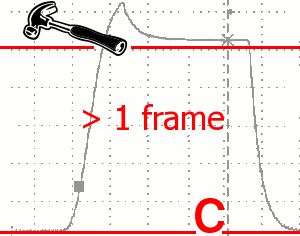20" LCD Monitors: XXL Displays
Overshoot
Since the 20WGX2 took more than one frame to stabilize, it rated a C on our rating system.
The Tom's Hardware Overdrive classification is a way of evaluating the precision of the Overdrive on LCD panels. How important is it? If the use of Overdrive is not under control, the colors displayed are not at all accurate during the space of more than one frame. The result is colors that are flashier than they should be. That's a problem with movies, where this phenomenon causes video noise. In animated images, this problem can manifest itself in the form of chromatic aberrations. Certain incorrect colors appear temporarily - red in a green-to-yellow transition, for example.
In Use
Finding the strong points of a glare filter is always difficult. For once, the brightness was well calibrated, which makes this a good monitor for office applications, especially since the sharpness of text was good, especially when connected via DVI. But, unless you like to work in the dark, there's a good chance that reflections from a window will get in your way. For photography work, as we said, the display is very accurate and the adjustments are pro quality. Unfortunately, the black level is not very deep and the "glossy" photo rendering won't be to everybody's taste.
The 20GX2 redeemed itself with gaming applications. The display was fast and the lack of precise transitions wasn't too obvious. And playing games in the dark is doable. The display's resolution is quite interesting for games with high definition, like World of Warcraft, for example.
Video Games
We rate the unit's suitability for gaming on a scale of 5. To do so, we try the panels with different games, such as FPS, RTS and RPG titles. The panel's reactivity is obviously the first point we're interested in, but the quality of the colors also has its importance with certain titles. To put the icing on the cake, this monitor's pixel interpolation was quite good. You'll be able to play at 1024x768 without losing image quality.
Get Tom's Hardware's best news and in-depth reviews, straight to your inbox.
But for video, the results were poor: we noted a lot of video noise on color masses, and the reflections in the panel were really bothersome. The lack of uniformity in the upper part of the panel was also too perceptible. This is clearly not the best monitor for watching your favorite movies.
Video
Here again we use a 5-point rating system. While latency plays a role, we also evaluate the amount of video noise induced by the display. Good viewing angles are also crucial for multimedia use.
Performance / Price
Rather than estimate a quality/price ratio, we prefer to concentrate on the price/performance ratio. What's the difference? The quality of an LCD display varies from one individual to another. Somebody who wants a sturdy monitor they can take anywhere but for whom performance is secondary will have a very different idea of what quality is than someone who wants a fast monitor but doesn't care much about its finish. On the other hand, performance is measurable. So this rating is a synthesis of the monitor's performance as compared to the Tom's Hardware benchmark.
Conclusion
Overall, this NEC monitor didn't impress us. That's a shame, since its color rendering was by far the most exact we've ever seen on a display with a glare filter. But that's not enough to overcome its shortcomings - limited uniformity, contrast that falls a little short, and video noise that was too evident.
